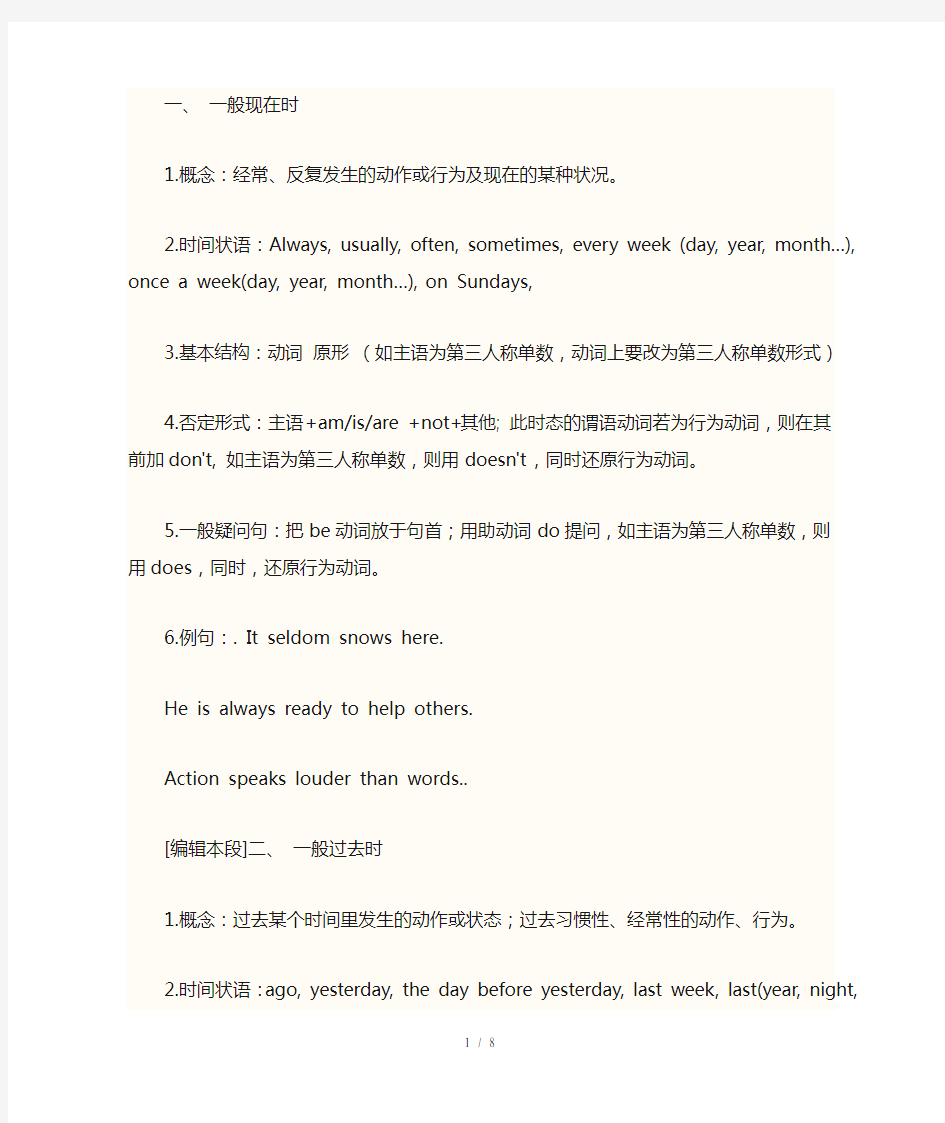初中英语时态大全

- 1、下载文档前请自行甄别文档内容的完整性,平台不提供额外的编辑、内容补充、找答案等附加服务。
- 2、"仅部分预览"的文档,不可在线预览部分如存在完整性等问题,可反馈申请退款(可完整预览的文档不适用该条件!)。
- 3、如文档侵犯您的权益,请联系客服反馈,我们会尽快为您处理(人工客服工作时间:9:00-18:30)。
一、一般现在时
1.概念:经常、反复发生的动作或行为及现在的某种状况。
2.时间状语:Always, usually, often, sometimes, every week (day, year, month…), once
a week(day, year, month…), on Sundays,
3.基本结构:动词原形(如主语为第三人称单数,动词上要改为第三人称单数形式)
4.否定形式:主语+am/is/are +not+其他; 此时态的谓语动词若为行为动词,则在其前加don't, 如主语为第三人称单数,则用doesn't,同时还原行为动词。
5.一般疑问句:把be动词放于句首;用助动词do提问,如主语为第三人称单数,则用does,同时,还原行为动词。
6.例句:. It seldom snows here.
He is always ready to help others.
Action speaks louder than words..
[编辑本段]二、一般过去时
1.概念:过去某个时间里发生的动作或状态;过去习惯性、经常性的动作、行为。
2.时间状语:ago, yesterday, the day before yesterday, last week, last(year, night, month…), in 1989, just now, at the age of 5, one day, long long ago, once upon a time, etc.
3.基本结构:be动词;行为动词的过去式
4.否定形式:主语+was/were +not+其他;在行为动词前加didn't,同时还原行为动词。
5.一般疑问句:was或were放于句首;用助动词do的过去式did 提问,同时还原行为动词。
6.例句:She often came to help us in those days.
I didn't know you were so busy.
[编辑本段]三、现在进行时
1.概念:表示现阶段或说话时正在进行的动作及行为。
2.时间状语:Now, at this time, days, etc. look. listen
3.基本结构:主语+be +doing +其他
4.否定形式:主语+be +not +doing+其他
5.一般疑问句:把be动词放于句首。
6.例句:How are you feeling today?
He is doing well in his lessons.
[编辑本段]四、过去进行时
1.概念:表示过去某段时间或某一时刻正在发生或进行的行为或动作。
2.时间状语:at this time yesterday, at that time或以when引导的谓语动词是一般过去时的时间状语等。
3.基本结构主语+was/were +doing +其他
4.否定形式:主语+was/were + not +doing+其他
5.一般疑问句:把was或were放于句首。(第一个字母大写)
6.例句:At that time she was working in a PLA unit.
When he came in, I was reading a newspaper.
[编辑本段]五、现在完成时
1.概念:过去发生或已经完成的动作对现在造成的影响或结果,或从过去已经开始,持续到现在的动作或状态。
2.时间状语:yet,already,just,never,ever,so far,by now,since+时间点,for+时间段,recently, lately, in the past few years, etc.
3.基本结构:主语+have/has +p.p(过去分词)+其他
4.否定形式:主语+have/has + not +p.p(过去分词)+其他
5.一般疑问句:have或has。
6.例句:I've written an article.
The countryside has changed a lot in the past few years.
[编辑本段]六、过去完成时
1.概念:以过去某个时间为标准,在此以前发生的动作或行为,或在过去某动作之前完成的行为,即“过去的过去”。
2.时间状语:Before, by the end of last year (term, month…), etc.
3.基本结构:主语+had + p.p(过去分词)+其他
4.否定形式:主语+had + not +p.p(过去分词)+其他
5.一般疑问句:had放于句首。
6.例句:As soon as we got to the station, the train had left.
By the end of last month. We had reviewed four books
基本结构:主语+had+p.p(过去分词)+其他
①肯定句:主语+ had+p.p(过去分词)+其他
②否定句:主语+ had+ not+p.p(过去分词)+其他
③一般疑问句:Had+主语+p.p(过去分词)+其他
④特殊疑问句:特殊疑问词+一般疑问句
[编辑本段]七、一般将来时
1.概念:表示将要发生的动作或存在的状态及打算、计划或准备做某事。
2.时间状语:T omorrow, next day(week, month, year…),soon, in a few minutes, by…,the day after tomorrow, etc.
3.基本结构:主语+am/is/are +going to + do+其他;主语+will/shall + do+其他
4.否定形式:主语+am/is/are not going to do ;主语+will/shall not do+其他
5.一般疑问句:be放于句首;will/shall提到句首。
6.例句:They are going to have a competition with us in studies.
It is going to rain.
[编辑本段]八、过去将来时
1.概念:立足于过去某一时刻,从过去看将来,常用于宾语从句中。
2.时间状语:The next day (morning, year…),the following month(week…),etc.
3.基本结构:主语+was/were +going to + do+其他;主语+would/should + do+其他
4.否定形式:主语+was/were/not + going to + do; 主语+would/should + not + do.
5.一般疑问句:was或were放于句首;would/should 提到句首。
6.例句:He said he would go to Beijing the next day.
[编辑本段]九、将来完成时
1.概念:在将来某一时刻之前开始的动作或状态
2.时间状语:by the time of; by the end of+时间短语(将来);by the time+从句(将来)
3.基本结构:主语+be going to/will/shall + have+p.p(过去分词)+其他
4例句:By the time you get back, great changes will have taken place in this area.
[编辑本段]十、现在完成进行时
1.概念:表示从过去某一时间开始一直延续到现在的动作。这一动作可能刚刚开始,也可能仍在继续,并可能延续到将来。
2.基本结构:主语+have/has +been +doing+其他
3.时间状语:since+时间点,for+时间段等。
4.例子:I have been sitting here for an hour.The children have been watching TV since six o'clock.
